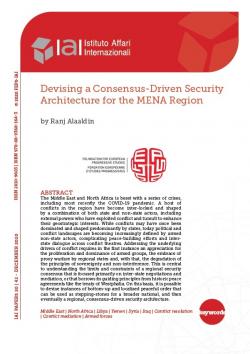Devising a Consensus-Driven Security Architecture for the MENA Region
The Middle East and North Africa is beset with a series of crises, including most recently the COVID-19 pandemic. A host of conflicts in the region have become inter-locked and shaped by a combination of both state and non-state actors, including external powers who have exploited conflict and tumult to enhance their geostrategic interests. While conflicts may have once been dominated and shaped predominantly by states, today political and conflict landscapes are becoming increasingly defined by armed non-state actors, complicating peace-building efforts and inter-state dialogue across conflict theatres. Addressing the underlying drivers of conflict requires in the first instance an appreciation for the proliferation and dominance of armed groups, the embrace of proxy warfare by regional states and, with that, the degradation of the principles of sovereignty and non-interference. This is central to understanding the limits and constraints of a regional security consensus that is focused primarily on inter-state negotiations and mediation, or that borrows its guiding principles from historic peace agreements like the treaty of Westphalia. On this basis, it is possible to devise instances of bottom-up and localised peaceful order that can be used as stepping-stones for a broader national, and then eventually a regional, consensus-driven security architecture.
Paper produced in the framework of the FEPS-IAI project “Fostering a New Security Architecture in the Middle East”, December 2020.
-
Details
Rome, IAI, December 2020, 20 p. -
In:
-
Issue
20|42 -
ISBN/ISSN/DOI:
978-88-9368-164-3
Introduction
1. Geopolitical shifts and fragmented security orders
2. Consensus-driven frameworks fit for 21st-century warfare
3. Building blocks for peace: Findings from the Proxy Wars Initiative
Conclusion and policy options
References
Topic
Tag
Related content
-
Ricerca20/02/2020
Fostering a New Security Architecture in the Middle East
leggi tutto



